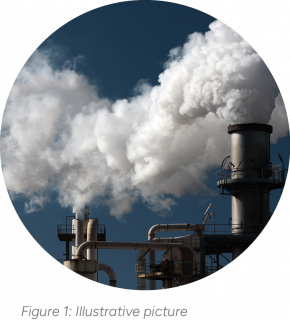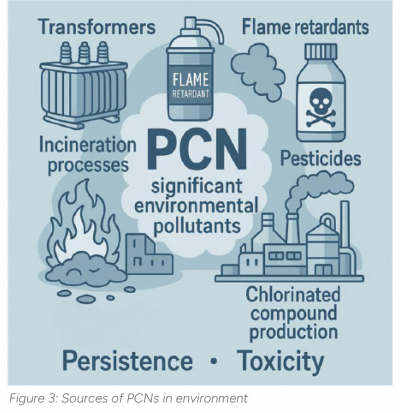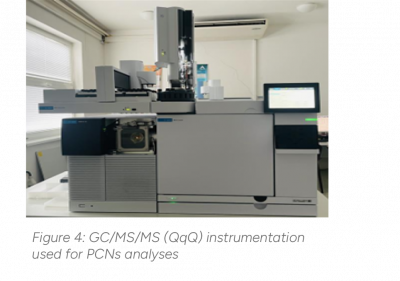Determination of Polychlorinated Naphthalenes
in Solid and Aqueous Matrices
Published: May 2025
Download PDF
EnviroMail_27_Europe_Determination of Polychlorinated Naphthalenes in Solid and Aqueous Matrices

Polychlorinated naphthalenes (PCNs) are classified as Persistent Organic Pollutants (POPs) - toxic substances characterized by their long environmental persistence and tendency to bioaccumulate in living organisms. Consequently, POPs in general, including PCNs, are regulated under EU Regulation 2019/1021 on POPs. ALS Laboratories offers analytical services for the determination of these compounds in various environmental samples.
PCNs Introduction
PCNs are a class of compounds in which hydrogen atoms are replaced by chlorine atoms in the naphthalene ring. In total, 75 congeners have been identified according to the number and position of the chlorine atoms (positions 1 to 8), their general formula is C10H8-nCln. Individual congeners differ in their degree of chlorination and physicochemical properties. Due to their persistence and toxicity, PCNs are considered to be significant environmental contaminants.

PCNs share many chemical properties with polychlorinated biphenyls (PCBs), such as high chemical and thermal stability, low flammability, and lipophilicity. These characteristics made PCNs attractive for a wide range of industrial applications throughout the 20th century. PCNs were first synthesized in 1833 and were used commercially from the early 1900s until the 1980s.
Due to their high thermal stability, hydrophobicity, and inertness, PCNs served as dielectric fluids in capacitors, insulating materials for wires and cables, wood preservatives, retardants, engine oil additives, and as raw materials for dye production. Estimated production of technical PCNs was
150,000–400,000 tons. Historical manufacturing and improper disposal represent significant sources of environmental contamination. Additionally, PCNs are formed as unintentional byproducts in various industrial processes, such as municipal solid waste incineration, iron ore sintering, secondary copper smelting, and other metallurgical operations. Even though the production and use of PCNs are now strictly regulated or banned, the legacy of early production and current unintentional releases has resulted in their detection across various environmental media and in food.
Because PCNs are highly resistant to chemical and biological degradation, they persist in soils, sediments, water, and the atmosphere for decades. Their low water solubility and high affinity for organic solvents enable them to bioaccumulate in living organisms and biomagnify up the food chain. Lower chlorinated PCNs (mono- or dichloronaphthalenes) are typically oily liquids found in the vapor phase, while highly chlorinated congeners (such as hexa-, hepta-, or octachloronaphthalenes) are waxy solids that tend to adhere to particles and accumulate in sediments.
Human Health Risks Associated with PCNs
Exposure to PCNs has been linked to various adverse health effects, such as neurotoxicity, hepatotoxicity, immune suppression, and endocrine disruption, which can cause reproductive and developmental problems. Higher chlorinated PCNs, particularly hexachloronaphthalene, are especially toxic and may act similarly to dioxins. Due to their persistence, toxicity, and bioaccumulation, PCNs were added to the Stockholm Convention in 2015.
Accurate quantification of PCNs emissions is essential for effective policy and risk management. Although global inventories are limited, recent studies identify key sources, including iron and steel production, waste incineration, and non-ferrous metal industries. New global emission inventories, using modeling methods and atmospheric transport analysis, are crucial for understanding PCNs distribution and guiding targeted reduction strategies to minimize environmental and health risks.

Determination of PCNs in ALS Laboratories
At ALS we use the most modern analytical method for the determination of PCNs that covers determination of chlorinated groups from monochloronaphthalenes to octachlorophthalenes and, if necessary, selected congeners (Table 1) in waste, aqueous and solid matrices.


For these purposes, we use gas chromatography coupled with high-resolution mass spectrometry (GCHRMS) or gas chromatography coupled with tandem mass spectrometry with a triple quadrupole (GC-MS/MS). Both techniques use electron ionization and are based on the isotope dilution method using isotopelabeled standards, ensuring high accuracy and reliability of results. The developed method achieves limits of quantification defined by EU Regulation 2019/1021 on persistent organic pollutants, making it suitable for comparison of results with legislatively established limits.
References
- Lee Ha-Hyun, Lee Sunggyu, Lee Jung Suk, Moon Hyo-Bang: Distribution of Polychlorinated Naphthalenes in Sediment From Industrialized Coastal Waters of Korea With the Optimized Cleanup and GC-MS/MS Methods, Frontiers in Marine Science 8 (2021) DOI: 10.3389/fmars.2021.754278.
- Technical specification ISO/TS 16780.
- Regulation EU 2019/1021 on persistent organic pollutants.
- Alwyn R. Fernandes, Anna Kilanowicz, Joanna Stragierowicz, Michał Klimczak, Jerzy Falandysz:
The toxicological profile of polychlorinated naphthalenes (PCNs), Science of The Total Environment 837 (2022) DOI: 10.1016/j.scitotenv.2022.155764.


